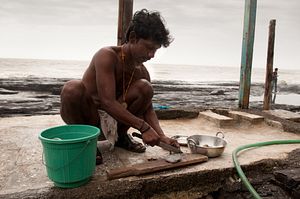As I discussed last week, the Narendra Modi government’s performance regarding the protection of Scheduled Tribes’ land rights and the protections of other communities dependent on India’s forest lands is on extremely shaky grounds at the two-year mark.His other promise in this regard was towar Scheduled Castes (SCs) and Other Backward Classes (OBCs) – and here, the government has been treading carefully. Dalit (a term used to refer to communities that have historically been victim to caste-based oppressive practices like untouchability) caste groups are significant stakeholders to whom the government promised empowerment through entrepreneurship and education. The Bharatiya Janata Party (BJP) and Modi have been extremely keen on showing solidarity with this community, but some of their attempts have gone astray in the process.
First, in the case of reservations (quotas for minorities) for SC/ST groups, the Modi government came under fire on speculation that it wished to scrap the policy. This speculation began when Rashtriya Swayamsevak Sangh (RSS) representative Mohan Bhagwat questioned the efficacy of the policy and called for its review in September 2015. The RSS has been acknowledged by many as the BJP’s ideological mentor, and thus these statements were assumed to be ones the government would eventually act upon. Twice this year, the RSS has since clarified that they did not want a complete scrapping of the policy at all, and Modi reiterated his commitment to keeping the policy in place at the Ambedkar Memorial Lecture in Delhi in March 2016 as well.
Nevertheless, perceptions that reservations are on the backslide have not been helped by a Supreme Court call to the Modi government to end reservations in institutes of higher education. Moreover, the 117th Amendment to the Constitution Bill, which undoes Supreme Court judgments that have rendered states unable to reserve seats for SCs and STs in promotion, has not been introduced in the Lok Sabha (the lower house of the Indian Parliament) by the government. Passed in 2012 by the Rajya Sabha (upper house), only passage in the Lok Sabha will once more enable aggrieved SC/ST individuals to seek judicial remedy in such cases. The non-passage of this bill has further called into question the government’s commitment to reservations.
Next, while campaigning in May 2016, Modi compared the child mortality rate among Dalits and tribal communities in Kerala to that of Somalia, sparking the ire of Dalit activists in the state. They proceeded to question his own success in securing the welfare of manual scavenging communities in his home state of Gujarat and pointed out an equal onus on the part of the central government in contributing to minority development, rather than just leaving it to the states.
Despite such setbacks, however, the Modi government has overall made attempts to reiterate its commitment to India’s Dalits. For instance, in April 2016, the government strengthened the provisions of the Prevention of Atrocities Act, established to protect caste minorities. This was a key change that provided better compensation for victims and also sped up the trial process. Further, they have taken efforts to commemorate Dalit icons like BR Ambedkar (head of the Constituent Assembly, which drafted the Indian Constitution). On multiple occasions, Modi has publicly professed to being a “bhakt” or devotee of Ambedkar and his government has pushed forward the commission of two memorials for Ambedkar.
In April 2016, on the birth anniversary of Dalit leader Babu Jagjivan Ram, Modi launched “Standup India,” with a specific government scheme for Dalit entrepreneurs. Introduced in Noida, Uttar Pradesh, it grants loans of between $15,000 and $150,000 for new enterprise setup. This came on the heels of similar promises on August 15, the Indian Independence Day, as well as Modi’s meetings with Dalit entrepreneurs in December 2015. At the National Conference of SC/ST Entrepreneurs, he set the grounds for this scheme by declaring a focus on financial inclusion and setting up a venture capital fund for backward classes. Further, a brainstorming session with Dalit entrepreneurs was held by the Prime Minister’s Office (PMO) and the founder of the Dalit Indian Chamber of Commerce and Industry (DICCI), Milind Kamble.
The “Standup India” venture provides pre-loan training, facilitates loans, assists with factoring and marketing, and even provides debit cards and a web portal for registration and support services. Twelve other similar plans for financial security parallel this venture. For instance, 5,100 e-rickshaws (miniature cabs which operate on a solar powered battery) were distributed to poor families during the launch of the initiative. “Standup India” is expected to benefit 250,000 Dalit entrepreneurs across the country in the long run.
However, an analysis by the Business Standard on the state of Dalit entrepreneurship in India seems to suggest that these efforts have been insufficient. While 125,000 entrepreneurs might supposedly gain over the next three years, 199 million Dalits are believed to be in the 18-35 age group, according to the DICCI. The venture thus makes a very small dent, even at its most successful.
Overall, while Modi has definitely ensured that the question of rights for SC/ST/OBC groups has not fallen off his government’s agenda entirely, his commitment to pushing forward the interests of these groups seems to be playing second fiddle to a broader notion of supposed development. Where the two agendas coincide, his efforts have shown some success, though it remains to be seen how well they can be sustained and developed. Where the two clash, either there is a lack of will in pushing the agenda of minorities forward, or they become subsumed within the larger rhetoric of development and relegated to the status of forgotten stakeholders.
This is the second in a two-part series on the Modi government’s treatment of India’s Scheduled Castes and Tribes. Read the first installment on India’s Scheduled Tribes here.

































